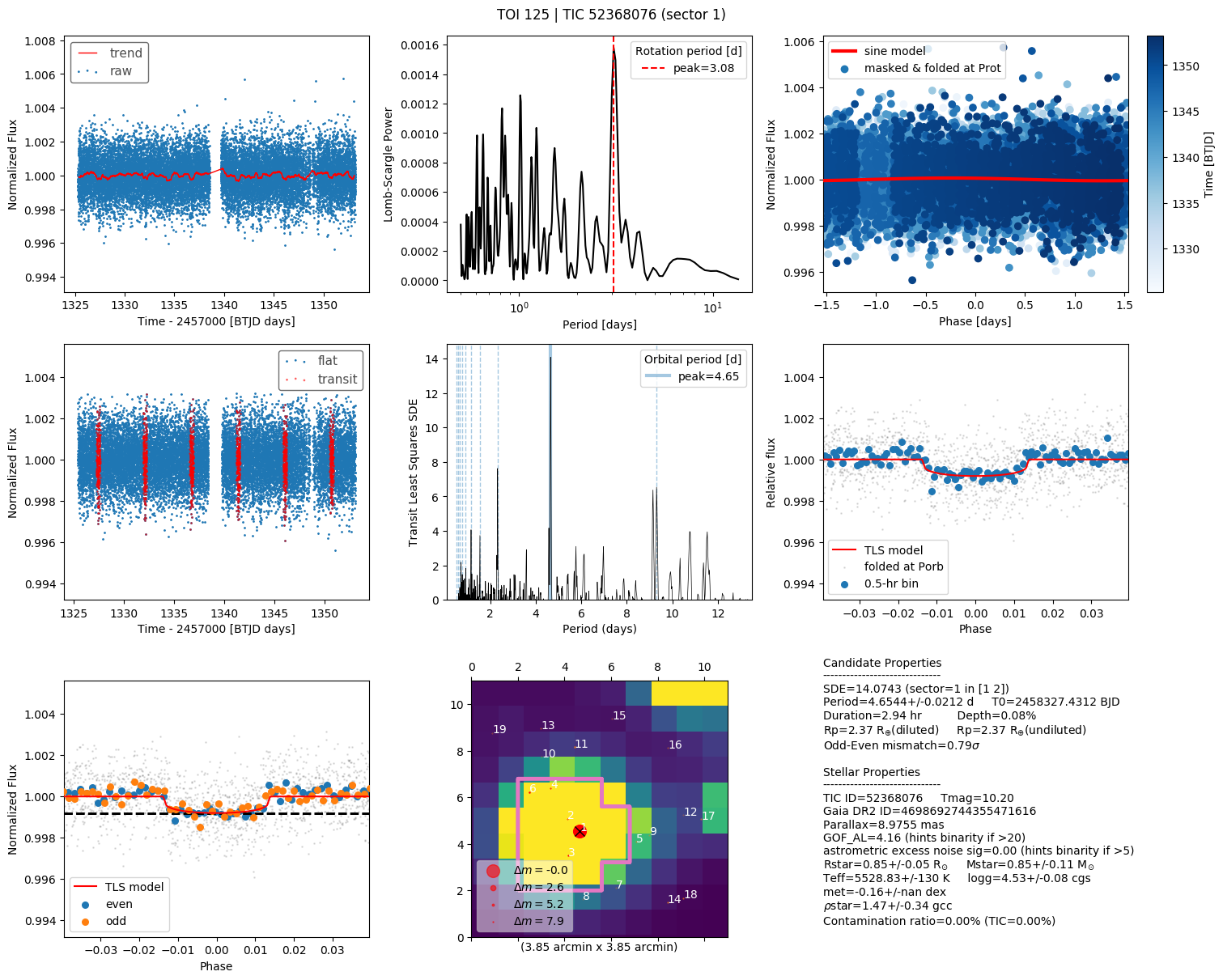TESS Quick Look plot generator. Note that chronos is a dependency.
optional arguments:
-h, -help show this help message and exit
-gaia GAIA Gaia DR2 ID
-toi TOI TOI ID
-tic TIC TIC ID
-coords COORDS COORDS
08:09:10 -05:04:23 or 22.5 -12.56
-name NAME target name
-sec SECTOR, -sector SECTOR
TESS sector
-c {long,short}, -cadence {long,short}
30-min long or 2-min short (default)
-sr SEARCH_RADIUS, -search_radius SEARCH_RADIUS
search radius in arcsec (default=3)
-lc {pdcsap,sap,custom,cdips}, -lctype {pdcsap,sap,custom,cdips}
type of lightcurve
-a {pipeline,round,square,percentile,threshold}, -aper_mask {pipeline,round,square,percentile,threshold}
aperture mask type
-t THRESHOLD, -threshold THRESHOLD
mask threshold in sigma
-r APER_RADIUS, -aper_radius APER_RADIUS
mask radius in pix
-perc PERCENTILE, -percentile PERCENTILE
mask percentile
-qb {none,default,hard,hardest}, -quality_bitmask {none,default,hard,hardest}
-size CUTOUT_SIZE, -cutout_size CUTOUT_SIZE
FFI cutout size for long cadence (default=[12,12] pix)
-m FLATTEN_METHOD, -flatten_method FLATTEN_METHOD
wotan flatten method (default=biweight)
-w WINDOW_LENGTH, -window_length WINDOW_LENGTH
flatten method window length (default=0.5 days)
-e EDGE_CUTOFF, -edge_cutoff EDGE_CUTOFF
cut each edges (default=0.1 days)
-qm, -quality_mask remove chunks of bad cadences identified in data
release notes
-plims PERIOD_LIMITS PERIOD_LIMITS, -period_limits PERIOD_LIMITS PERIOD_LIMITS
period limits in periodogram search; default=(1,
baseline/2) days
-b BIN_HR, -bin_hr BIN_HR
bin size in folded lc (default=4 hr if -c=long else
0.5 hr)
-n NEARBY_GAIA_RADIUS, -nearby_gaia_radius NEARBY_GAIA_RADIUS
nearby gaia sources to consider (default=120 arcsec)
-u, -use_priors use star priors for detrending and periodogram
-g, -gls run GLS pipeline
-f, -find_cluster find if target in cluster
-s, -save save figure and tls
-o OUTDIR, -outdir OUTDIR
output directory
-v, -verbose show details- Show quick look plots of TOI 125 (with details printed in the terminal using -v) $ tql -toi 125 -v
The generated figure shows 9 panels (see plot below):
- top row
- left: background-subtracted, PLD-corrected lightcurve and trend
- middle: lomb-scargle periodogram
- right: phase-folded at peak stellar rotation period (if any)
- middle row
- left: flattened lightcurve and transit (determined from TLS on the right)
- middle: TLS periodogram
- right: phase-folded lightcurve at orbital period
- bottom row
- left: phase-folded lightcurve of odd and even transits with transit depth reference
- middle: tpf with overlaid TESS aperture and annotated gaia sources
- right: summary info
$ tql -tic 52368076 -v -s (uses pdcsap by default)
$ tql -toi 125.01 -v -s -lc sap
$ tql -toi 125.01 -v -s -sec 2 (specify sector)
$ tql -toi 125 -v -s -c long (long cadence)
$ tql -toi 125.01 -v -a pipeline (default aperture)
$ tql -toi 125.01 -v -a round -r 1 (round aperture 1 pix in radius)
$ tql -toi 125.01 -v -a square -r 2 (square aperture 2 pix in radius)
$ tql -toi 125.01 -v -a percentile -perc 90
$ tql -toi 125.01 -v -a threshold -t 5
$ tql -toi 125.01 -v -a threshold -g (gls periodogram)
If you would like to run tql on a list of TIC IDs (saved as new_tics.txt), then we have to make a batch script named run_tql_new_tics.batch. Its output files containing the plots (.png) and tls_results (.h5) will be saved in new_tics directory:
$ cat new_tics.txt | while read tic; do echo tql -tic $tic -pld -s -o ../new_tics; done > run_tql_new_tics.batch
To test the Nth line of the batch script,
$ cat run_tql_new_tics.batch | sed -n Np | sh
To run all the lines in parallel using N cores (use -j<48 cores so that muscat-ut will not be very slow!),
$ cat run_tql_new_tics.batch | parallel -j N
After the batch script is done, we can rank TLS output in terms of SDE using rank_tls script:
$ rank_tls indir
- find additional planets by iterative masking of transit
- implement vetting procedure in sec 2.3 of Heller+2019


